Jelita coat of arms
| Jelita | |
|---|---|
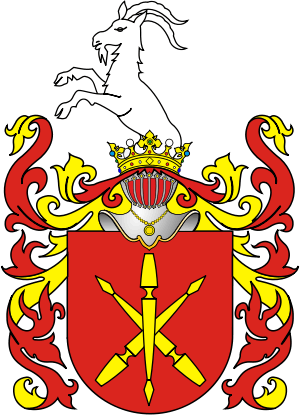 | |
| Details | |
| Battle cry | Jelita, Nagody |
| Alternative names | Hastae, Jelito, Koźlarogi, Koźle Rogi, Tres Hastae |
| Earliest mention | 1316 (seal) |
| Families |
551 names Agewski, Ajewski, Alkiewicz, Anszeński, Antonowicz, Aszeński. Badyński, Balowicz, Barczkowski, Białecki, Białocki, Białowiecki, Bielawski, Bielczewski, Bielski, Biesiad, Biesiadecki, Biesiadowski, Biesiadzki, Bilczewski, Bilczowski, Bliżyński, Bobrykiewicz, Boglewski, Bogurski, Bohyła, Bonin, Borzemski, Borzobohaty, Borzyński, Brodecki, Bukowiński, Bury, Buszkowski. Chaiński, Chilchen, Chlebowicz, Chorążyna, Chuchrowski, Cielimoński, Cielimowski, Cielmowski, Cieluśnicki, Cieskanowski, Cieszanowski, Czeczel, Czeczela, Czeluściński, Czerkas, Czerkaski, Czerkawski, Czerkies, Czermieński, Czermiński, Czerniński, Czerszyński, Czerwakowicz, Czop, Czubka. Dąbrowski, Dembowski, Derkaczowski, Dębowski, Dobrożyński, Dobryński, Dobrzyński, Dobuchowski, Drozdowski, Drożewski, Dubowieski, Duranowski, Dyss, Dziadowski, Dziaduski, Działowski, Dzibałtowski, Dziduski, Dziebałtowski, Dzieciątkowski, Dziewałtowski, Dziugłowski, Dziwisz, Dzyryt. Faliński, Fanuel, Francuz, Francuzewicz, Francuzowicz. Gajewicz, Gajewski, Gawin, Gawlikowski, Gawłowski, Gąska, Gdeszycki, Gedytt, Gerdut, Gielitko, Gierdud, Gierecki, Giertut, Gierzyński, Gieszyński, Gintowt-Dziewałtowski, Girzyński, Glora, Głowa, Głowacki, Głowaczewski, Głupiecki, Godell, Godzianowski, Godziewski, Godziński, Goliszewski, Gołocki, Gomoliński, Goniprowski, Gorlewski, Gorliwski. Halczyniecki, Hałoski, Hałowski, Held, Helt, Homolicki. Idaszewski, Idzelewicz, Idzellewicz, Inowłodzki, Iskrzycki, Iwonia. Jabłoński, Jacewicz, Jackiewicz, Jagiełłowicz, Jajkowski, Jakliński, Jakowicki, Jakowicz, Jakowiecki, Jaksztowicz, Janicki, Jankiewicz, Jankowski, Jarosławski, Jasieński, Jasiński, Jaworski, Jaykowski, Jazdowski, Jekliński, Jelita, Jelitko, Jelitowski, Jerzbutowicz. Kaczorowski, Kaleński, Kalina, Kalino, Kaliński, Kaliski, Kalisz, Kałowski, Kamisowski, Kamocki, Kamyszowski, Kaufman, Kędzierzyński, Kępiński, Kicki, Kisielewski, Kliszewski, Kliszowski, Kliziński, Kluszczyński, Kmita, Knyszyński, Kobielski, Kochlewski, Kolbrzyński, Kołyszka, Kołyszko, Komornicki, Konstantynowicz, Kopijewicz, Koprzywnicki, Korytko, Korytkowski, Korytnicki, Korytowski, Korzyński, Kosowski, Kossowski, Koślarowski, Kotlicki, Kowalowski, Koziarowski, Kozielecki, Kozierowski, Koziołkowski, Koziołowski, Koźlarowski, Koźloróg, Kórzyński, Kraiński, Krasieński, Krasowski, Krassowski, Kropiński, Kropiwnicki, Krzęcki, Kuczyński, Kuncewicz, Kusiecki, Kwiatkiewicz, Kwiatkowicz. Lapczyński, Lasochowski, Lasota, Lassochowski, Lassota, Leniecki, Lganowski, Libicki, Libidzki, Litosławski, Litwinowicz, Litwiński, Lneżeliński, Lochiński, Lochński, Lochyński, Lubecki, Lubicki, Luczeliński, Luczyliński, Luczywiński, Ludkiewicz, Lutkiewicz, Lutkowicz, Lutosławski, Lutostański, Lutoszewski. Łańczyński, Łapczeński, Łapczyński, Łapiński, Łaziński, Łaźnicki, Łaźniński, Łażnicki, Łażniński, Łącki, Łęcki, Łochański, Łochiński, Łochyński, Łodygowski, Łodykowski, Łohyński, Łotocki, Łuczeliński, Łuczyleński, Łuczywiński, Łukiewicz, Łukowicz, Łukowski. Machnicki, Madurowicz, Majeranowski, Majkowski, Makowski, Makułowicz, Malecki, Maljewski, Małecki, Marcinkowski, Marowicki, Martynowski, Marzęcki, Matecki, Matkiewicz, Micewicz, Michałowski, Michaniewski, Miczewicz, Miekaniewski, Mierski, Mietelski, Minczewski, Mirski, Misiekiewicz, Misiewicz, Misiewski, Misiowski, Misiurewicz, Missiewicz, Missowicz, Mniński, Mniszek, Modrzewski, Mojaczewski, Mojkowski, Mokrski, Mongin, Moraniecki, Moraniewski, Morawicki, Morawiecki, Morawieński, Morowiński, Moroz, Morozewicz, Morozowicz, Morozsz, Moszczański, Moszczeński, Moykowski, Mrawiński, Mrowiński, Mszerewicz, Myszejko, Myszeyko, Myśliborski, Myślicki. Neronowicz, Nieronowicz, Niewiadomski, Nowosielecki, Nurowski. Pabianowski, Pacanowski, Pachołowiecki, Padarewski, Paderewski, Pagiewski, Pajewski, Pajowski, Palski, Paprocki, Pawłowski, Peczlewicz, Peczulewicz, Pełczyski, Perlicki, Pęczycki, Pieczkowski, Pieczulewicz, Pieczykowski, Pieniążek, Pietuch, Pijakowski, Piottuch, Piotuch, Piszkowicz, Piwakowski, Plachowicz, Podgórski, Podstękalski, Podstolski, Pokrzywnicki, Poleski, Popczyński, Popławski, Postękalski, Poznański, Pozylewicz, Pratkowski, Promieński, Promiński, Promnicki, Proniewicz, Proszczyński, Przybyłowski, Pudelski, Pudłowski. Raciborowski, Raczkowski, Radogoscki, Radogoski, Radoszkowski, Rafalski, Raj, Rajczenko, Rajski, Rampalski, Ray, Rayski, Remiesz, Remiszewski, Remiszowski, Reszczewski, Romaszewski, Romer, Romiszewski, Romiszowski, Rosowski, Rospąd, Rospęd, Rozdziałowski, Rozniecki, Rozpąd, Rożniecki, Rożnowski, Rudlicki, Rychcicki, Rychczycki, Rykaczewski, Rymgayło, Rymgayłowicz, Rzepliński. Sadowski, Salecki, Sancygniowski, Saryusz, Sczerbic, Sczukocki, Secygniewski, Secygniowski, Sędzigniewski, Sieliski, Sielnicki, Sietecki, Silnicki, Skarbek, Skąpski, Skępski, Skierko, Skokocki, Skokowski, Skorkowski, Skórkowski, Skrzynicki, Skrzyniecki, Slowiński, Sławianowski, Słupski, Sokolnicki, Sokołowicz, Sołowicki, Sołowiński, Stanowski, Staropis, Stawirejski, Staworski, Stawowski, Stokowski, Strumecki, Strumieński, Strus, Struś, Strzałkowski, Strzeszkowski, Suchoczaski, Sudimont, Sudkiewicz, Sudymont, Sudywoj, Swarpłowicz, Swieczyk, Sypniewski, Sypniowski, Sypnowski, Syroczyński, Szadkowski, Szarski, Szczekocki, Szczepankiewicz, Szczepankowicz, Szczerbicz, Szczukocki, Szczurowski, Szpachiński, Szpakiński, Szpaliński, Szparkowski, Szubalski, Szydłowski, Szypieński. Tarnawski, Tarnowski, Tatarski, Tchorzenicki, Tchorznicki, Terlikowski, Tomasz, Trawiński, Trzebiatowski, Tulicki. Ul. Wałowski, Wągleszyński, Werburt, Werbut, Węchadłowski, Węgleszyński, Wieloch, Wierzejski, Wierzyński, Wikoszewski, Wikszemski, Wilczkowski, Wilkoszewski, Wilkowski, Wilner, Witkowski, Witorowicz, Witoszyński, Witowicz, Wojciechowski, Wojnowski, Wojtkiewicz, Wolski, Wolski-Saryusz, Wolszleger, Worszyło, Woźnicki, Wrzesiński, Wrzeszyński, Wrześniowski, Wyłaski, Wyrzejski, Wyrzyski. Zakrzewski, Zakrzowski, Zaleski, Zalewski, Zamojski, Zamoyski, Zarszyński, Zawisza, Zboiński, Zbojeński, Zdunowski, Zdziechowski, Zelecheński, Zielawski, Zieliński, Zieliński-Saryusz, Zurowski. Żarkowski, Żelawski, Żelecheński, Żelechowski, Żelechyński, Żelesiński, Żeleziński, Żeleżyński, Żełeżyński, Żeromski, Żurawski, Żurowski. |
| Cities | Dyneburg (1582–1772), Kraśnik, Tomaszów Lubelski, Józefów Biłgorajski, Zamość, Zwierzyniec |
| Gminas | Gmina Dłutów, Gmina Jadów, Gmina Moszczenica, Gmina Morawica, Gmina Tereszpol |
Jelita is a Polish coat of arms. It was used by several szlachta families.
History
One of the oldest Polish coats of arms. Firstly depicted on the seal of Tomisław z Mokrska from 1316.
Additionally, the Polish medieval chronicler, diplomat and soldier Jan Długosz referred to those bearing the Jelita coat of arms as "a clan born in Poland of men who are modestly devoted to dogs and hunting."
Legend
However, the legend says that coat of arms was granted by King Władysław Łokietek to a peasant soldier (and his family) after the Battle of Płowce (1331) in which the Polish armies defeated the 40,000-strong force of the Teutonic Knights with minimal casualties. The man fought with great courage and only fell in battle when pierced by three spears in the abdominal region which caused his bowels to fall out. Shortly before death the King ennobled the fatally wounded man. Hence the three crossed spears in the coat of arms as well as the name Jelita - Bowels or Guts.
Notable bearers
Notable bearers of this coat of arms include:
- House of Zamoyski
- Adam Zamoyski
- Jan Zamoyski
- Joanna Barbara Zamoyska
- Gryzelda Konstancja Zamoyska
- Jan "Sobiepan" Zamoyski
- Tomasz Zamoyski
- Florian Pacanowski
- Józef Śliwicki
- Ignacy Jan Paderewski
- Franciszek Dąbrowski
- Stefan Żeromski
- Witold Lutosławski
- Ryszard Kaczorowski
- Jacek Saryusz-Wolski
Gallery
-
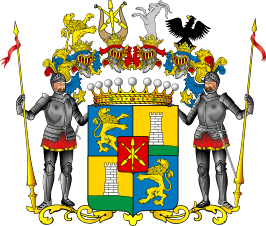
Coat of arms of Counts Zamoyski
-

Coat of arms of Counts Bielski
-

Gorłowski (odm.)
-

Hilchen (odm.)
-
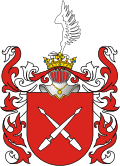
Geometer (odm.)
-

Jelita III (odm.)
-

Koźlakowski (odm.)
-
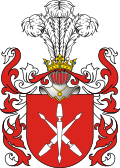
Manikowski (odm.)
-

Maszalski (odm.)
-
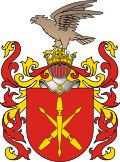
Natalis (odm.)
-

Serny (odm.)
-
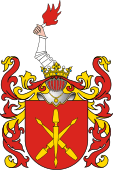
Sienicki (odm.)
-
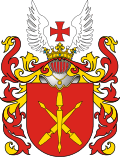
Słowieński (odm.)
-
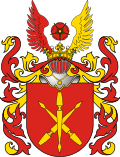
Szczerbic (odm.)
-

Szydłowski (odm.)
-
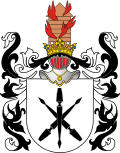
Wielkołucki (odm.)
See also
Bibliography
- Tadeusz Gajl: Herbarz polski od średniowiecza do XX wieku : ponad 4500 herbów szlacheckich 37 tysięcy nazwisk 55 tysięcy rodów. L&L, 2007. ISBN 978-83-60597-10-1.
- Alfred Znamierowski: Herbarz rodowy. Warszawa: Świat Książki, 2004, s. 112. ISBN 83-7391-166-9.

